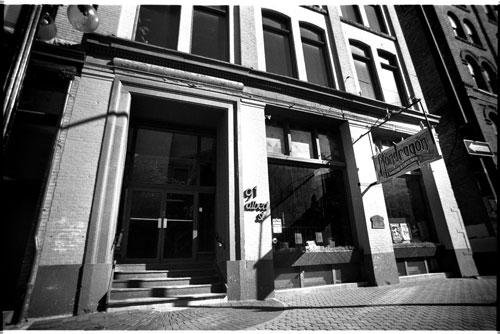The A-Zone: A Brief History
The Old Market Autonomous Zone (or A-Zone) was founded in the Fall of 1995, in a three-story heritage building at 91 Albert Street in the Exchange District of Winnipeg. The building itself was built in 1899, and is sometimes referred to as the “Imperial Dry Goods” building. In 1935, it was turned into the Young Men’s Hebrew Association (YMHA), complete with 3rd floor gymnasium and theatre, before the YMHA moved to Hargrave Street in 1952. Each of the three floors are roughly 3,666 square feet, for a total building area of 10,998 square feet (plus the basement).
In 1995 the A-Zone was founded with the express purpose of bringing together a diverse, but inter-connected array of people and organizations committed in very broad terms to social justice — whether this be feminist organizations, indigenous organizations, grassroots solidarity and human rights groups, anarchist book clubs, prisoner solidarity groups, or alternative worker-run businesses. (See a brief overview of the principles behind the A-Zone.)
The A-Zone membership has changed over the years. but the principles underlying the building and space remain the same. In particular, the A-Zone is committed to helping build left, community, and worker-run organizations — in order to contribute to the growth of self-sustaining infrastructure for the activist community, and for future generations. A critical component of this is supporting organizations that consciously attempt to eliminate hierarchies and divisions of labour based on, among other things, colour, class, gender, and knowledge — regardless of the particular focus and emphasis of the group. The A-Zone has invested directly in such community economic development and radical infrastructure by offering massively-subsidized rents to fledgling organizations committed to participatory economic and revolutionary principles — at least, long enough to help such organizations or workers’ collectives get started. Organizations such as Mondragón Bookstore & Coffeehouse, Arbeiter Ring Publishing, G-7 Welcoming Committee, Natural Cycle, and DadaWorldData Productions have all benefited from initial A-Zone subsidy in this respect, particularly in their early months and years. For the most part, these organizations have also remained core members, comrades, and allies of the A-Zone going into its second decade of existence.

It is difficult to separate the history of the A-Zone from the histories of its many member organizations, and from the individual people who use and support the building. It is important to note, however, that the A-Zone (like Mondragón on the first floor) has become a focal point for activism, for planning and holding events, and for socializing and fostering a community (or communities) of resistance in Winnipeg. The first ten years of our existence have witnessed the birth and growth of many worthy, worker-run collectives within our walls — most of which remain solid members of the A-Zone. Furthermore, many early and long-time members of the A-Zone, Mondragón, G-7 and other groups have gone on to other worthwhile projects, both within Winnipeg as well as other cities — bringing their experiences and skills and insights to bear in many diverse places. To name only a few examples: ex-Mondragon member Steve Kirk, and long-time A-Zone supporters and Wobblies such as Heather Hall, went on to co-found Organic Planet Worker Co-op. Ex-Mondragon and Arbeiter Ring member Ria Julien moved to New York and now works at Seven Stories Press. Mondragon co-founder Jim Sanders went on to help found DWD Productions, a video documentary collective. Mondragón co-founder and ex-G-7 member Lorna Vetters went on to become a member of the AK Press collective in San Francisco. And of course, many, many long-time supporters of the A-Zone, and members of its many groups, continue to engage in day-to-day organizing and activism, on a range of issues (anti-war, anti-racist, labour and union organizing, First Nations solidarity, refugee support, prison abolition, ecology, animal liberation, and so on).
We hope the next ten years will witness a further growth of ideas and institutions, a strengthened (and ever-more economically-viable) A-Zone, and an expanded, and more welcoming community of activism and resistance in Winnipeg and beyond!